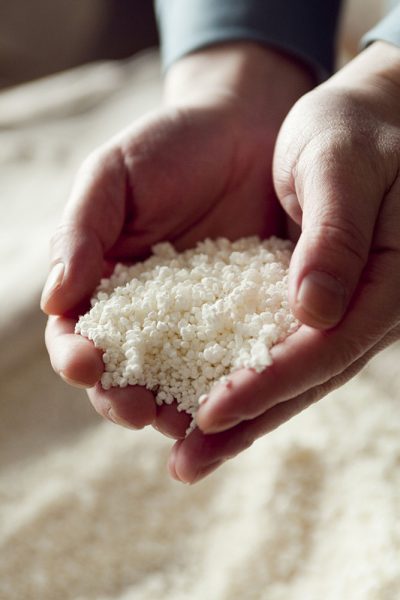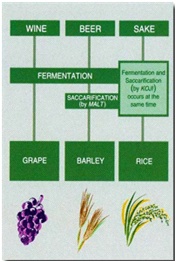Made from the simple ingredients of rice and water, sake is completely natural.
Sake is a naturally fermented alcoholic beverage classified in the same general category with wine and beer. These beverages are made through a fermentation process which, essentially is the conversion of glucose into alcohol through the work of yeast. However, due to the differences in ingredients, the corresponding fermentation processes required for producing each product vary in degree of complexity.
Sake is made from the simple ingredients of rice and water. Containing no artificial additives, enhancers or sulfites, Gekkeikan sake is completely natural. It is also a great way to add unique flavor to your favorite dishes. It is perfect for use in stir-fries, marinades, sauces and a variety of other recipes. Like beer and wine, sake is lower in both alcoholic content and calories when compared to distilled liquors. But unlike wine and distilled liquors, freshness is the key to good taste. With production taking place in our California brewery year round, Gekkeikan is able to consistently deliver fresh, high quality sake.

Nutritional Information of Sake |
|
| Calorie | 108 kcal |
| Protein | 0.5 g |
| Fat | less than 0.1 g |
| Sugar | 5.0 g |
| Dietary Fiber | less than 0.1 g |
| Calcium | 1.6 mg |
| Iron | less than 0.1 g |
| Sodium | 3.7 mg |
| Potassium | 2.9 mg |
| Magnesium | 0.9 mg |
| Vitamin B1 | 3.0 μg |
| Per 100 ml (3.3 oz) of Gekkeikan Traditional Sake 15.6% alc/vol | |
Caloric Information |
|
| Sake | 105 ~ 110 kcal |
| Beer | 40 ~ 70 kcal |
| Wine | 80 ~ 100 kcal |
| Shochu | 110 ~ 200 kcal |
| Whiskey | 225 ~ 250 kcal |
| Per 100ml (3.3 oz.) | |


Ways of Drinking Sake
The Japanese often serve sake at a temperature to match the time of year or the style of food it will accompany. This custom is so widespread that the Japanese language itself includes special words for sake depending upon the temperature at which it is served. Warmed or slightly heated sake is called kan. When kan is served at 45°C (113°F), its fullness of body and mellow flavor become more pronounced making this a popular choice during the cooler months or when paired with refreshingly light fare. Enjoyed in this fashion, kan is particularly soothing.
Chilled sake is called hiya. Hiya generally assumes a fresh, fruity character and is particularly refreshing during warm weather, but can be equally enjoyable throughout the year. Some sakes are brewed specifically to be served chilled, such as many of the premium sakes. This is in order to preserve the subtle, delicate flavor that warming can destroy. Other sakes are brewed to be more versatile and tend to have a slightly heartier flavor that is enjoyable both chilled and warmed.
Japanese Culture and Sake
Traditional Japanese culture makes frequent use of sake as a way to observe a seasonal holiday or mark a special event. As such, sake is imbibed on such occasions as toasting the New Year, celebrating a local festival or solemnizing a wedding vow. Whether served in an antique porcelain cup or a small wooden cup (masu), whether spiced with herbs or garnished with flower petals, sake plays a special role in ceremonial aesthetics.
Today sake is most often enjoyed according to personal preference in casual atmospheres. Individuals may select the season, occasion, food, and surroundings that suit their own tastes.
